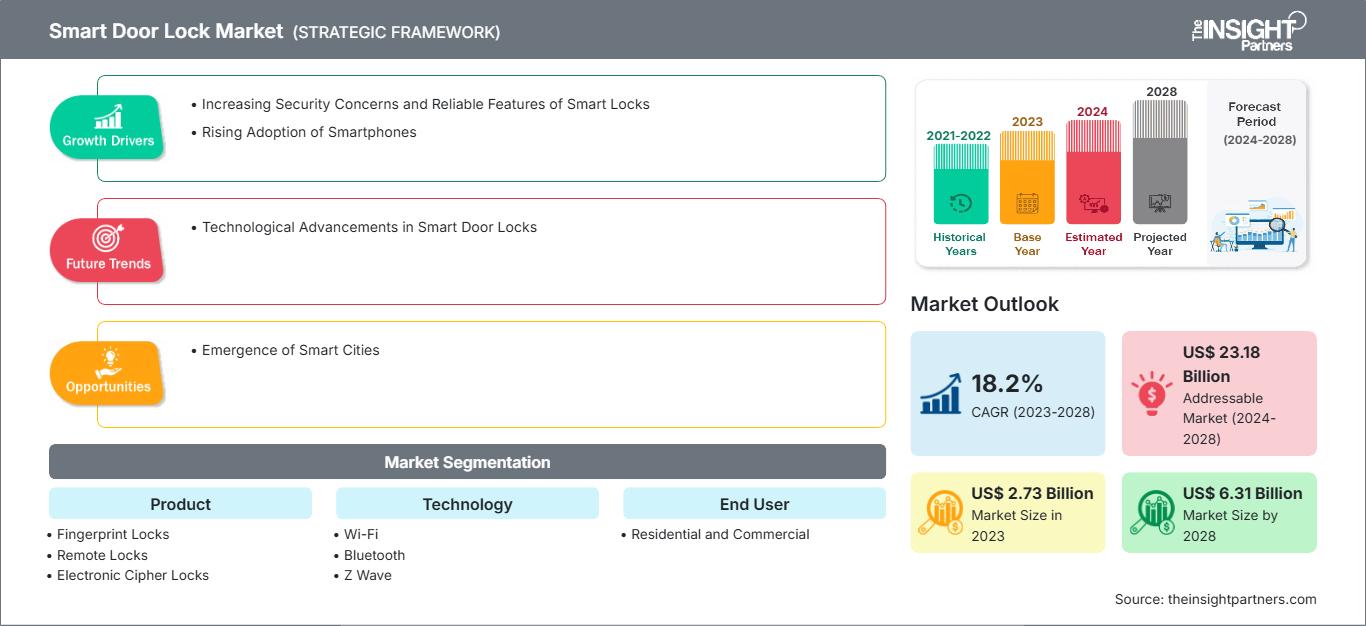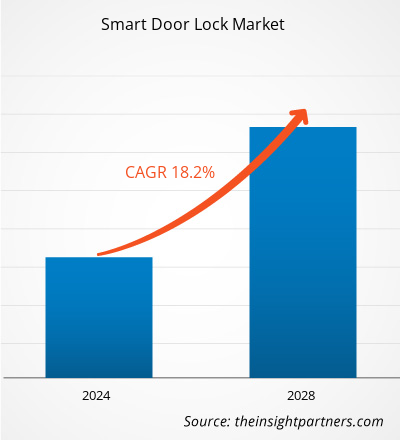[Forschungsbericht]Der Markt für intelligente Türschlösser soll von 2.733,05 Millionen US-Dollar im Jahr 2023 auf 6.309,13 Millionen US-Dollar im Jahr 2028 wachsen; von 2023 bis 2028 wird ein durchschnittliches jährliches Wachstum von 18,2 % erwartet.
Intelligente Türschlösser sind fortschrittliche Schließsysteme, die sicheren und bequemen Zugang zu Gebäuden oder Räumen ohne physischen Schlüssel ermöglichen. Intelligente Türschlösser können durch elektronische Authentifizierungsmethoden wie biometrische Erkennung, numerische Codes oder Funksignale ver- und entriegelt werden. Intelligente Türschlösser werden in Wohnhäusern, Geschäftsgebäuden, der Gastronomie, Bildungseinrichtungen, Gesundheitseinrichtungen und anderen Bereichen eingesetzt. Der zunehmende Trend und die Implementierung des Internets der Dinge (IoT) sowie das wachsende Sicherheits- und Datenschutzbewusstsein fördern die weltweite Verbreitung von Smart-Home-Sicherheitsgeräten. Das wachsende Verbraucherbewusstsein für die Vorteile fortschrittlicher Sicherheitslösungen dürfte den Markt für intelligente Türschlösser ankurbeln.
Der weltweite Anstieg der Smartphone-Nutzer hat in den letzten Jahren zu einem verstärkten Einsatz intelligenter Türschlösser geführt. Diese Schlösser zeichnen sich durch eine benutzerfreundliche Oberfläche und hohe Bedienfreundlichkeit aus. Das stetig wachsende Bewusstsein für sichere Heimlösungen, die Entwicklung intelligenter Geräte wie Smartphones, steigende verfügbare Einkommen der Verbraucher, zunehmende Sicherheitsbedrohungen, die Entwicklung intelligenter Städte und die boomende Internetkonnektivität tragen zusätzlich zum Wachstum des Marktes für intelligente Türschlösser bei. Die intelligenten Türschlösser integrieren Kommunikationstechnologien wie Bluetooth, WLAN, Z-Wave, RFID und NFC.
Passen Sie diesen Bericht Ihren Anforderungen an
Sie erhalten kostenlos Anpassungen an jedem Bericht, einschließlich Teilen dieses Berichts oder einer Analyse auf Länderebene, eines Excel-Datenpakets sowie tolle Angebote und Rabatte für Start-ups und Universitäten.
Markt für intelligente Türschlösser: Strategische Einblicke

-
Holen Sie sich die wichtigsten Markttrends aus diesem Bericht.Dieses KOSTENLOSE Beispiel umfasst Datenanalysen, die von Markttrends bis hin zu Schätzungen und Prognosen reichen.
Auswirkungen der COVID-19-Pandemie auf die globale Marktanalyse für intelligente Türschlösser
Die COVID-19-Pandemie hatte auf ihrem Höhepunkt im Jahr 2020 dramatische Auswirkungen auf die Weltwirtschaft, und die Krise behinderte die Geschäftsaktivitäten im verarbeitenden Gewerbe. Vor der COVID-19-Pandemie erlebte der Markt für intelligente Türschlösser aufgrund des kontinuierlich steigenden Lebensstandards ein erhebliches Wachstum im privaten und gewerblichen Sektor. Mehrere Branchen, wie z. B. die Halbleiter- und Elektronikindustrie, standen vor Herausforderungen bei der Projektentwicklung, Lieferung, Herstellung sowie Forschung und Entwicklung neuer Produkte. Eine steigende Nachfrage nach kontaktlosen Produkten aufgrund von Lockdown- und Social-Distancing-Maßnahmen kam dem Markt für intelligente Türschlösser jedoch zugute.
Die COVID-19-Pandemie beeinträchtigte Lieferkettenabläufe, Investitionen, Produktion und langfristige Strategien in verschiedenen Branchen. Hersteller hatten aufgrund von Quarantänemaßnahmen der Regierungen verschiedener Länder Schwierigkeiten, Geschäftsentwicklungsaktivitäten durchzuführen, was zu Änderungen ihrer Routineabläufe führte. Darüber hinaus zwang die Pandemie Unternehmen dazu, ihre Geschäftsmodelle umzustrukturieren und sich auf Strategien zur Erzielung von Skaleneffekten zu konzentrieren. Diese Faktoren behinderten den Fortschritt des Marktes für intelligente Türschlösser im Jahr 2020.
Markteinblicke – Marktanalyse für intelligente Türschlösser
Technologische Fortschritte bei intelligenten Türschlössern werden das Marktwachstum in den kommenden Jahren fördern
Verschiedene Akteure auf dem Markt für intelligente Türschlösser integrieren künstliche Intelligenz (KI), maschinelles Lernen (ML) und andere ähnliche Technologien in ihre intelligenten Schlösser. KI- und ML-integrierte Türschlösser sorgen für mehr Sicherheit zu Hause, indem sie verfolgen, wer die Türen öffnet und schließt. Darüber hinaus bieten diese Schlösser mehr Kontrolle darüber, wer Türen ver- und entriegeln kann. Sie ermöglichen es Benutzern auch, Türen automatisch zu ver- oder entriegeln, wenn sie ihr Zuhause verlassen oder sich ihm nähern. Die KI- oder ML-integrierten Schlösser können helfen, Einbruch- oder Schlossmanipulationsversuche zu erkennen. Daher bietet die Integration fortschrittlicher Technologien den Akteuren auf dem Markt für intelligente Türschlösser lukrative Wachstumschancen.
Verschiedene Akteure auf dem Markt für intelligente Türschlösser bringen neue Produkte mit der Integration fortschrittlicher Technologien auf den Markt, um der wachsenden Nachfrage nach intelligenten Türschlössern gerecht zu werden. Im Dezember 2022 brachte Viomi das Viomi AI Smart Door Lock Super 2E auf den Markt. Dieses vollautomatische intelligente Türschloss unterstützt sechs Entriegelungsmethoden: Fingerabdruck, Passwort, virtuelles Passwort, temporäres Passwort, Türkarte und Schlüssel. Es verfügt über eine selbstlernende KI-Technologie, die mit der Zeit sensibler wird. Im April 2023 brachte Geonfino drei neue intelligente Schlösser auf den Markt – das Fingerabdruck-Türschloss Geonfino G4 Pro, das intelligente Schloss Geonfino G4 Pro+G2 und das intelligente Schloss Geonfino S1 Pro – mit einer Sechs-in-Eins-Entriegelungsmethode, die Fingerabdruck, Anwendung, Passwort, IC-Karte, physischen Schlüssel und Gateway-Steuerung umfasst. Im Februar 2023 stellte Xiaomi seine neue Xiaomi Smart Door Lock M20-Serie vor. Das neue Modell, Smart Guardian Can See, ist mit einer integrierten Türspionkamera und einem Display ausgestattet, das dem Nutzer in Echtzeit einen umfassenden Überblick über die Haustür bietet. Zusätzlich verfügt das Modell über eine Türklingelfunktion für mehr Komfort. Die Einführung intelligenter Schlösser mit neuen Technologien zur Erhöhung der Sicherheit wird das Marktwachstum für intelligente Türschlösser im Prognosezeitraum weiter vorantreiben.
Markt für intelligente Türschlösser
Markt für intelligente TürschlösserDie Analysten von The Insight Partners haben die regionalen Trends und Faktoren, die den Markt für intelligente Türschlösser im Prognosezeitraum beeinflussen, ausführlich erläutert. In diesem Abschnitt werden auch die Marktsegmente und die geografische Lage in Nordamerika, Europa, dem asiatisch-pazifischen Raum, dem Nahen Osten und Afrika sowie Süd- und Mittelamerika erörtert.Umfang des Marktberichts zum Thema intelligente Türschlösser
| Berichtsattribut | Einzelheiten |
|---|---|
| Marktgröße in 2023 | US$ 2.73 Billion |
| Marktgröße nach 2028 | US$ 6.31 Billion |
| Globale CAGR (2023 - 2028) | 18.2% |
| Historische Daten | 2021-2022 |
| Prognosezeitraum | 2024-2028 |
| Abgedeckte Segmente |
By Produkt
|
| Abgedeckte Regionen und Länder |
Nordamerika
|
| Marktführer und wichtige Unternehmensprofile |
|
Dichte der Marktteilnehmer für intelligente Türschlösser: Verständnis ihrer Auswirkungen auf die Geschäftsdynamik
Der Markt für intelligente Türschlösser wächst rasant. Die steigende Nachfrage der Endnutzer ist auf Faktoren wie veränderte Verbraucherpräferenzen, technologische Fortschritte und ein stärkeres Bewusstsein für die Produktvorteile zurückzuführen. Mit der steigenden Nachfrage erweitern Unternehmen ihr Angebot, entwickeln Innovationen, um den Bedürfnissen der Verbraucher gerecht zu werden, und nutzen neue Trends, was das Marktwachstum weiter ankurbelt.

- Holen Sie sich die Markt für intelligente Türschlösser Übersicht der wichtigsten Akteure
Verschiedene Akteure auf dem Markt für intelligente Türschlösser bringen fortschrittliche intelligente Türschlösser für erweiterte Sicherheitszwecke auf den Markt. Diese sind wie folgt:
- Im April 2023 brachte Geonfino, ein Hersteller intelligenter Türschlösser, drei intelligente Türschlösser auf den Markt, die über eine einzigartige Sechs-in-Eins-Entriegelungsmethode verfügen, um maximale Sicherheit und Komfort zu gewährleisten. Die intelligenten Türschlösser sind mit biometrischen Funktionen und Sprachsteuerung ausgestattet.
- Im Februar 2023 brachte Xiaomi ein intelligentes Türschloss mit integrierter Gucklochkamera und Bildschirm auf den Markt, das den Benutzern in Echtzeit eine umfassende Sicht auf die Haustür bietet.
Unternehmensprofil:
- Adel Marketing (M) SDN BHD
- Allegion plc
- Assa Abloy
- Guangdong level intelligent lock industrial co ltd
- Honeywell International Inc
- Spectrum Brands
- Locstar Technology Co Ltd
- Master Lock Company LLC
- Miwa Lock Co, Zigbang
- Historische Analyse (2 Jahre), Basisjahr, Prognose (7 Jahre) mit CAGR
- PEST- und SWOT-Analyse
- Marktgröße Wert/Volumen – Global, Regional, Land
- Branchen- und Wettbewerbslandschaft
- Excel-Datensatz
Aktuelle Berichte
Verwandte Berichte
Erfahrungsberichte
Grund zum Kauf
- Fundierte Entscheidungsfindung
- Marktdynamik verstehen
- Wettbewerbsanalyse
- Kundeneinblicke
- Marktprognosen
- Risikominimierung
- Strategische Planung
- Investitionsbegründung
- Identifizierung neuer Märkte
- Verbesserung von Marketingstrategien
- Steigerung der Betriebseffizienz
- Anpassung an regulatorische Trends






















 Kostenlose Probe anfordern für - Markt für intelligente Türschlösser
Kostenlose Probe anfordern für - Markt für intelligente Türschlösser